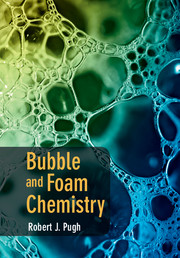Book contents
- Frontmatter
- Contents
- Preface
- Acknowledgments
- List of symbols
- 1 Basic principles and concepts
- 2 The nature and properties of foaming surfactants
- 3 Soap bubbles and thin films
- 4 Processes in foaming
- 5 Generation of bubbles and foams
- 6 Coalescence of bubbles in surfactant solutions
- 7 The stability/instability of bubbles and foams
- 8 Particle-stabilized foams
- 9 Foaming in non-aqueous liquids
- 10 Antifoaming and defoaming
- 11 Bubble size measurements and foam test methods
- 12 Bubble and foam chemistry - new areas of foam research
- Index
- References
1 - Basic principles and concepts
Published online by Cambridge University Press: 05 September 2016
- Frontmatter
- Contents
- Preface
- Acknowledgments
- List of symbols
- 1 Basic principles and concepts
- 2 The nature and properties of foaming surfactants
- 3 Soap bubbles and thin films
- 4 Processes in foaming
- 5 Generation of bubbles and foams
- 6 Coalescence of bubbles in surfactant solutions
- 7 The stability/instability of bubbles and foams
- 8 Particle-stabilized foams
- 9 Foaming in non-aqueous liquids
- 10 Antifoaming and defoaming
- 11 Bubble size measurements and foam test methods
- 12 Bubble and foam chemistry - new areas of foam research
- Index
- References
Summary
Thoughts without content are empty, intuitions without concepts are blind.
Immanual Kant, Critique of Pure Reason, B25, 1781.Introduction
Foams can exist in the wet, dry or solid state and can be seen almost everywhere, in the home, in the surrounding natural environment and in numerous technological applications. In fact they are prevalent, and it is almost impossible to pass through an entire day without having contact with some type of liquid or solid foam. They have several interesting properties which enable them to fill an extremely wide range of uses; for example, they possess important mechanical, rheological and frictional characteristics which enable them to behave similar to solids, liquids or gases. Under low shear, wet (bubbly) foams exhibit elastic properties similar to solid bodies, but at high shear, they flow and deform in a similar manner to liquids. On the application of pressure or temperature to wet foams, the volume changes proportionately, and this behavior resembles that of gases. Interestingly, it is the elastic and frictional properties of wet foams which lead to their application in personal hygiene products such as body lotions, foaming creams and shaving foams. While shaving, foam is applied to the skin and the layer on the blade travels smoothly over the surface, reducing the possibilities of nicking and scratching. Another example is their use as firefighting foams, where properties such as low density, reasonably good mechanical resistance and heat stability are required in order to be effective in extinguishing gasoline fires. Essentially, they act by covering the flames with a thick semi-rigid foam blanket. The low density allows the water in the foam to float even though it is generally denser than the burning oils. The chemical composition and mechanical properties of these types of foams can be varied to optimize the firefighting utility.
Foams are also found in many food items, either in finished products or incorporated during some stage in food processing. They primarily provide texture to cappuccino, bread, whipped cream, ice-cream topping, bread, cakes, aerated desserts, etc. Surprisingly, several novel types of food foams have been recently produced from cod, mushroom and potatoes, using specially designed whipping siphons powered by pressurized gas with lecithin or gelatin as alternative foaming agents to replace egg and creams (1).
- Type
- Chapter
- Information
- Bubble and Foam Chemistry , pp. 1 - 53Publisher: Cambridge University PressPrint publication year: 2016
References
- 2
- Cited by



